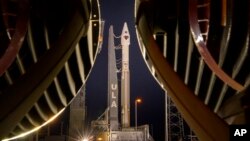The U.S. space agency, NASA, launched a craft Saturday to boldly go to a part of space never visited before — the asteroids of Jupiter.
The spacecraft Lucy took off before dawn Saturday from Cape Canaveral, Florida. It is embarking on a 12-year mission, during which it will travel more than 6 billion kilometers.
Lucy aims to fly near seven of Jupiter's Trojan asteroids. Thousands of asteroids surround the giant planet.
The asteroids are believed to be artifacts from when the solar system was formed, and scientists hope that by studying them, they can better understand how the solar system evolved.
Tom Statler, Lucy program scientist, told VOA in an email that the asteroids are "leftovers from the formation of our solar system's giant planets — Jupiter, Saturn, Uranus, and Neptune" and that "the formation and early evolution of the Earth was influenced by what was happening to the giant planets farther from the sun.
"The Trojan asteroids hold unique clues to this special era," he added.
NASA scientist Carly Howett told NASA TV that there are two main ideas of how the Trojan asteroids came to orbit near Jupiter: one, they formed deep in the solar system, and in a game of cosmic billiards were kicked back toward Jupiter; or two, they formed closer to Jupiter and are composed of substances similar to those of Jupiter's moons.
"We are going to learn a lot about the composition" of the asteroids, she said, which will help NASA learn how and where they were formed.
Wil Santiago, an engineer at Lockheed Martin Space, told NASA TV, "It's like going back in time. These asteroids are time capsules."
Lucy is named for the fossilized remains of an early human discovered in Ethiopia in 1974. NASA scientists say the spacecraft will hopefully provide clues about the solar system's evolution, just as the remains of the human ancestor Lucy were important in understanding how humans evolved.
The fossilized Lucy was in turn named for the 1967 Beatles song Lucy in the Sky with Diamonds. Coming full circle, NASA says there are diamonds in the instrument that will measure the temperature of the asteroids.
On its mission to Jupiter, Lucy will perform three Earth flybys for a gravity boost to propel it farther into the solar system. It will also fly by an asteroid in the main asteroid belt between Mars and Jupiter, in what scientists consider a test run before it approaches the Trojan asteroids.
The craft has two massive solar panels, 7 meters each, that will provide the power it needs to travel 850 million kilometers from the sun. Because of its large panels, the craft will not be nimble enough to make quick adjustments in its trajectory.
Howett said scientists will use the spacecraft's camera system to make sure there are no obstacles in its path, but added, "We're not going to be doing a U-turn — let's just put it like that."
To chart a safe course, she said, NASA has been using the world's best telescopes to study the region of space where Lucy will travel.
"We think we have an idea of what the risks are," Howett said; however, she added, "whenever you explore somewhere new, there are some hazards."
Lucy is not the only spacecraft exploring asteroids in the solar system. Next month, the spacecraft Dart is set to ram an asteroid 11 million kilometers from Earth in an attempt to change its course. The mission is a test of technologies that could be used one day to save Earth from a hazardous asteroid.
Also, next year, a craft will explore the asteroid Psyche, which is heavy with nickel and iron, and the following year, a space capsule will return to Earth with NASA's first samples from an asteroid, collected last year by the Osiris-Rex rover exploring the asteroid Bennu.
"It's going to be a great few years for asteroid science," Howett said.
With all the activity in space exploration right now, scientists are seeking to explore one of the few regions of the solar system that has yet to be visited.
The Trojan asteroids "are the last major population of objects in our solar system that have not yet been seen close-up by spacecraft," Statler said.








